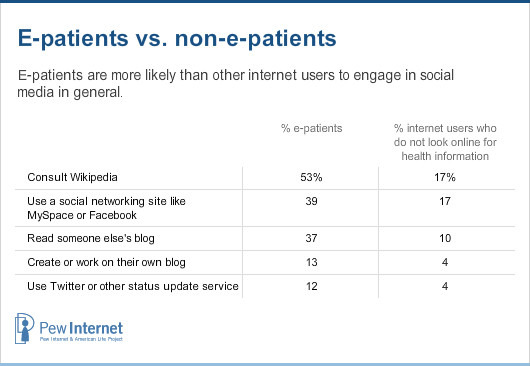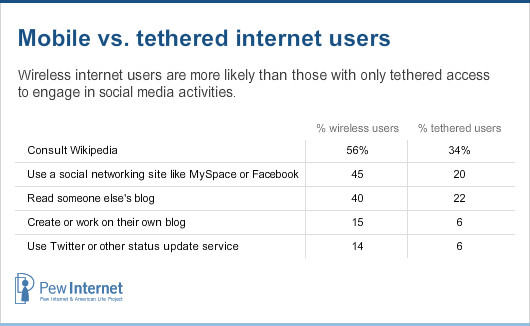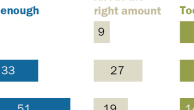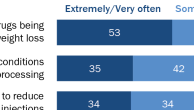Many seek a “just-in-time someone-like-me” but few post their own stories.
E-patients are using the internet to compare their options, just as they do with other major decisions,11 and to find the “just-in-time someone-like-me” who can aid their decision-making.
Fifty-nine percent of e-patients have done at least one of the following activities:
- 41% of e-patients have read someone else’s commentary or experience about health or medical issues on an online news group, website, or blog. About half of e-patients between the ages of 18-49 have read someone else’s commentary online, compared with about one-third of e-patients ages 50 and older.
- 24% of e-patients have consulted rankings or reviews online of doctors or other providers.
- 24% of e-patients have consulted rankings or reviews online of hospitals or other medical facilities.
- 19% of e-patients have signed up to receive updates about health or medical issues. Customized health bulletins are especially popular among e-patients age 50-64: 23% have signed up to receive such updates, compared with 14% of e-patients ages 18-29, for example.
- 13% of e-patients have listened to a podcast about health or medical issues.
E-patients with a college degree are more likely than those with a high school diploma to have done the top three activities (47% have read someone else’s commentary, for example, vs. 33% of e-patients with a high school diploma). E-patients with home broadband are more likely than those with dial-up access to have done all of these activities (26% of e-patients with home broadband have consulted online reviews of health professionals, for example, vs. 18% of those with dial-up).
Other recent studies found similar trends. For example, a 2009 Deloitte Center for Health Solutions survey found that a growing number of adults are “comparing doctors, hospitals, medications, devices, health plans and self remedies.”12 Edelman’s Health Engagement Barometer points out that “no single source of information stands out or stands alone” in the networked world of many health consumers.13 And yet the Center for Studying Health System Change finds that just 41% of patients have the knowledge and confidence required to manage their health in this new world.14
Indeed, the activation gap may extend online as there is not universal access to communication technologies. Someone’s “just-in-time someone-like-me” may not be online or they may not be speaking up in public forums.
Twenty percent of e-patients have done at least one of the following activities:
- 6% of e-patients have tagged or categorized online content about health or medical issues. E-patients ages 30-64 are more likely than older and younger e-patients to have tagged health content.
- 6% of e-patients have posted comments, queries, or information about health or medical matters in an online discussion, listserv, or other online group forum.
- 5% of e-patients have posted comments about health on a blog.
- 5% of e-patients have posted a review online of a doctor.
- 4% of e-patients have posted a review online of a hospital. E-patients ages 18-29 are more likely than older e-patients to have posted a hospital review.
- 4% have shared photos, videos or audio files online about health or medical issues.
60% of e-patients, or one-third of adults, access social media related to health.
In sum, 60% of e-patients, or 37% of U.S. adults, have done at least one of these eleven social media activities related to health and health care. As health economist Jane Sarasohn-Kahn writes, health-related social technologies capture “the exchange of health information and personal stories in a way that transcends both medical textbooks and chatting with a friend on the phone – yet offers some of the benefits of both.”15
Age is a significant predictor for accessing user-generated content related to health. About two-thirds of e-patients ages 18-49 have done at least one of the activities listed, compared with one-half of e-patients age 50 and older. Two-thirds of e-patients with broadband at home or wireless access have done at least one health social media activity on the list, compared with half of e-patients with dial-up at home or tethered access.
There are no significant differences among e-patients of various ages or education levels and there is no significant difference between e-patients with home broadband and those with dial-up access.
However, e-patients with mobile access to the internet are more likely than those who have tethered access to contribute their comments and reviews to the online conversation. Again, these data points echo “The Mobile Difference” report, which found that wireless access is associated with deeper engagement and participation in online communications.16
There are signs that the social media gap could close for health consumers. First, mobile technology is associated with deeper engagement in social media and an accelerated pace of information exchange. Second, adults between the ages of 18 to 49 are more likely than older adults to participate in social technologies related to health.
E-patients are more likely than other internet users to engage in social media in general.
It turns out that e-patients’ enthusiasm for social media is not limited to activities related to health. Internet users who have looked online for health information are more likely than non-health seekers to have created or worked on their own blog, read someone else’s blog, used a social network site, used Twitter or another status update service, and to have consulted Wikipedia. Even when controlling for age, education, and other variables, being an e-patient emerges as a significant predictor for other social media engagement.

Mobile access is another independent factor when it comes to predicting social media use. Internet users with wireless access are more likely than those who have only tethered access to engage in a full range of social media activities.





